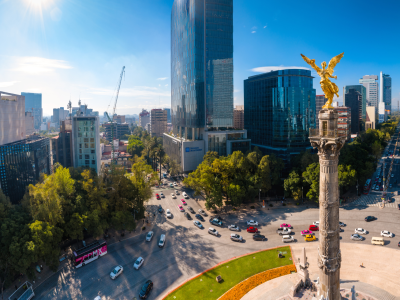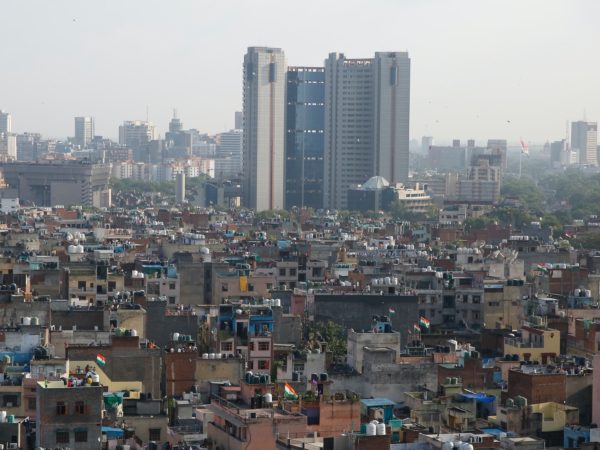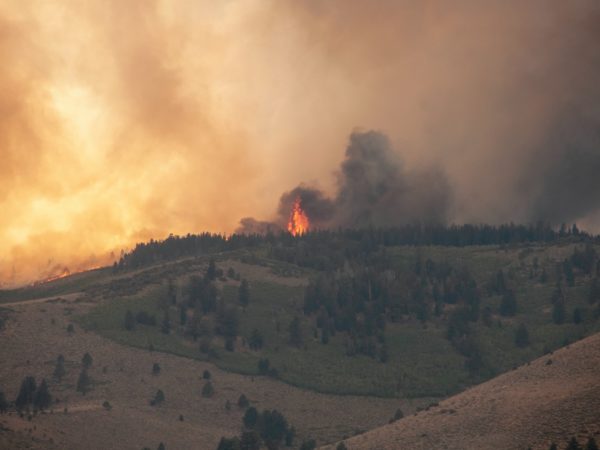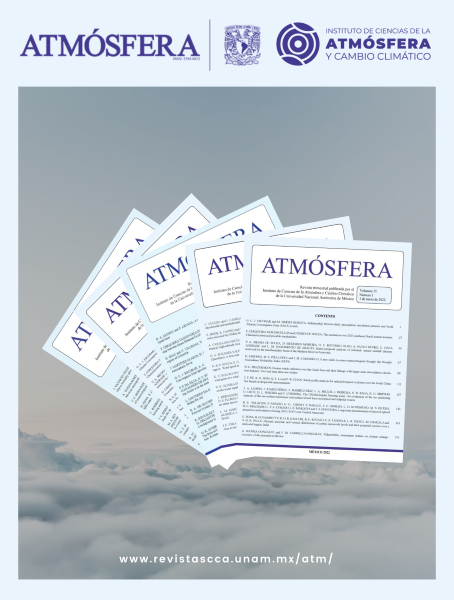Introduction
The vegetal pulp or lignocellulosic biomass does not escape from the economic principle of scarcity. Agricultural residues, like all resources in society, are limited; therefore, it is necessary to find the best alternative use for them, for example, as animal feed or for the production of bioenergy. The agricultural residues are limited in quantity, so their owners are faced with some assorted choices to optimize consumption (Mankiw, 2020). The lignocellulosic biomass -particularly agricultural and agro-industrial residues- faces diverse trade-off situations between its use as livestock feed (traditional use), as raw material to generate electricity and/or heat at home, and likewise generation for some industries such as sugar mills, brick making, craft industries, among others processes, residential heating by metal pellets, elaboration of biofuels (liquid, solid and gaseous), injection into the soil (nutrition and erosion prevention) or simply for hazardous-waste incinerators (Rincón Martínez et al., 2014).
The importance of each of the alternative uses of lignocellulosic biomass depends on its quantity, type, energy density, geographic concentration, harvesting costs, legal framework and, in general, on the existence of relevant markets in which its commercialization takes place (Becerra-Pérez et al., 2022). For example, agro-industrial waste usually has a high geographic concentration (sugar mills, sawmills, liquor industry, mezcal, coffee, fruits, etc.) so that their utilization has a profitable payout given their relatively low handling costs and nearly zero transportation costs.
In the case of agricultural residues, their high dispersion in the field and their low energy density raises the amount of transportation costs, which inhibits their use. In addition, the recent growing improvements in agricultural productivity have also increased the amount of residual biomass, which has caused problems in the incorporation of agricultural waste into the soil through the biological process of mineralization and humification, perhaps due to the short span to prepare land and grow crops on it, too. Among the relative disadvantages of excess agricultural residues are the weed control required, the formation of wet and cold soils, and poor seed placement and support (Linden et al., 2000); as well as the increased costs required for the elimination of excess residues, which implies the persistence of bad practices such as incineration, affecting the environment, public health and, in regions where the incineration of agricultural residues is prohibited; violating the legal framework (Becerra-Pérez et al., 2023).
In the central region of Mexico the corn, sorghum, wheat, and barley producers leave more than 50% of the residues on the cultivation site, using only 24% for animal feed, while 20% is incinerated (Reyes-Muro et al., 2013). Overall, an average of 23% of agricultural residues available in Latin America are burned in open fields (Aghaei et al., 2022).
Despite the damage provoked, burning of agricultural residues is still practiced in some regions and specific crops, e.g. sugarcane where 90% of the harvested area in Mexico still uses the traditional method of burning leaves before harvesting the stalk (CNPR, 2021). A range between 15% and 25% of total agricultural residues are used for livestock feed, while the rest is simply left in the field or incinerated on site, or otherwise (Reyes-Muro et al., 2013). Also Mexico there is a forage-livestock ratio of 1.6, which means that even discounting the biomass required for animal feed, there remains a high percentage (60%) of agricultural residues on the cultivated area, which can be used for bioenergy (Becerra-Pérez et al., 2019).
Trade-off situation of agricultural residues
Below is an analysis of the prevailing trade-off situation in agricultural residues when one of the two alternative uses is chosen: animal feed or cellulosic ethanol. Based on the theory of Tittonell et al. (2015), an explanation of the trade-off situation of agricultural residues is offered, using a diagram to facilitate the explanation. Figure 1 represents on the ordinate axis the utility provided by the stubble when used as livestock feed (LF), while the abscissa axis shows the utility of using it as an input for cellulosic ethanol (CE). In this, three possible scenarios are represented (1, 2, and 3) and, in addition, that the quality of the residues is uniform and does not change over time, at least in the short term, it is assumed.
The convex curve to the origin (red color, Fig.1) represents scenario 1, in which we assume develops in an environment of high competition for agricultural residues, what implies the existence of different exchange rates, depending on the point to be analyzed. For example, at point “13,1” the stubble represents, on the one hand, a highly appetible input as livestock feed and, on the other hand, as a low utility input for cellulosic ethanol. For a complete context, a livestock farming region where the primary activity is more highly valued; on the contrary, point “11,3” represents a low utility for livestock feed and a high valuation for ethanol, similarly to a more industrialized region and/or with low livestock farming activity. Please, note that if we start from point “13,1” and the aim is to produce a certain amount of ethanol (e.g. CE2), one oneself has to be willing to reduce the amount of residue destined for livestock feed by an amount of (LF3 – LF2) and increase the residue destined for ethanol by an amount of (CE2 – CE1), which implies an exchange rate of less (ΔLF/ΔCE) between the two alternative uses of stubble.
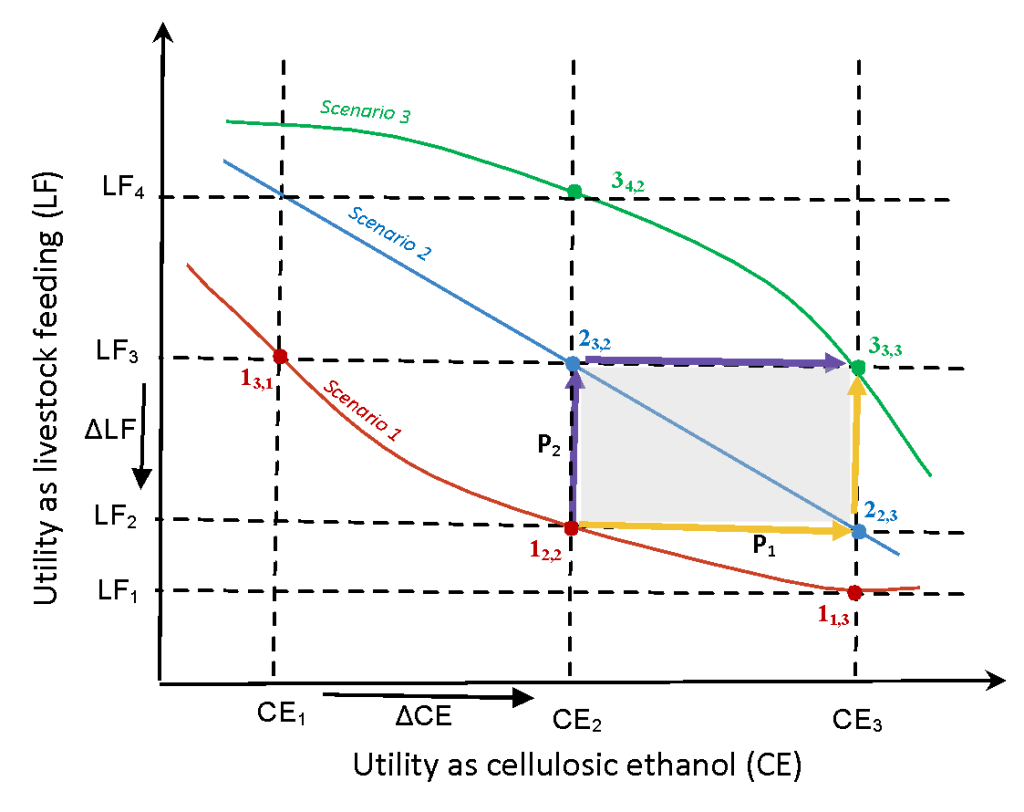
The linear curve (blue color, Fig. 1) represents scenario 2, which assumes conditions under perfect substitution of stubble between the two alternative uses. Let us assume that such a trade-off is equivalent from the point of view of the economic utility generated by the biomass. For example, if we start from point “23,2” in which the consumption of agricultural residues as livestock feed produces a utility of “LF3“, and the objective is to produce an amount of ethanol of “CE3“, we will have to give up a quantity of the stubble as livestock feed of (LF3 – LF2) and increase the stubble for ethanol use in an amount of (CE3 – CE2), which implies a volume of the same amount, expressed in an rate of exchange of minus (LF3 – LF2) / (CE3 – CE2) = -1 (in economic terms, that means perfect substitution i.e., an axiomatic exchange of equivalent utility).
The curve concave to the origin ( green color, Fig. 1) represents scenario 3, which depicts conditions of economic complementarity between the two alternative uses of agricultural residue. Anybody could think of consumption points below the optimum level, both for livestock feed and cellulosic ethanol; or else, at points where there is excess consumption in one of the uses, such that, by reducing consumption in that use, the utility through alternative uses increases more than proportionally. For example, moving from point “34,2” to “33,3” would imply reducing the utility of stubble for livestock feed by the amount of (LF4 – LF3) and increasing the utility of stubble for cellulosic ethanol by the amount of (CE3 – CE2), which shows a greater utility gained in cellulosic ethanol (CE) than the utility lost in livestock feed (LF), therefore there is a net economic benefit to society.
The rectangular area (shaded and marked with arrows, Fig. 1) shows the alternative routes that can be followed if the producing region is in scenario 1 (convex curve to the origin) and at a point such as “12,2“, from which it is desired to move towards an optimal point (scenario 3, point “33,3“). Given this assumption, one possibility is to travel along route “P1“, passing first through the point “22,3” of scenario 2, and then detour to the optimal point. Another possibility is to move along route “P2“, passing first through point “23,2” of scenario 2, and then moving towards the optimal point. Of course, society, throughout the sum of individual decisions of economic agents, can move along “n” number of routes, technically demarcated by the area shaded of the central rectangle in Figure 1.
Conclusion
Considering the alternative applications of resources can lead us to complement their sustainability analysis. Furthermore, by carrying out a techno-economic weighing of cellulosic ethanol, a more affordable and sustainable scenario can be achieved, allowing for the design of fairer and more appropriate public policies for each region of Mexico. When resources are limited in quantity (even if they were typified as agricultural waste), any decision to use them in a specific economic activity implicitly implies the cost of not allocating them to another production option (opportunity cost) whatsoever.
References
Aghaei, S.; Alavijeh A.K.; Shafiei M.; Karimi, K.A. A comprehensive review on bioethanol production from corn stover: Worldwide potential, environmental importance, and perspectives. Biomass and Bioenergy 2022, 161, 106447.
Becerra-Pérez, L.A.; Rincón, L.E.; Posada-Duque, J.A. Anhydrous Ethanol Pricing in Economies with an Underdeveloped Biofuels Market: The Case of Mexico. Sustainability 2023, 15, 7084.
Becerra-Pérez, L.A.; Rincón, L.E.; Posada-Duque, J.A. Logistics and Costs of Agricultural Residues for Cellulosic Ethanol Production. Energies 2022, 15, 4480.
Becerra-Pérez, L.A.; Tyner, W.E.; García-Paez, B. Cellulosic Ethanol in Mexico: An Appraisal as Industrial Feedstock. In: Digambar, N.P. (Ed.) Advances in Renewable Energy Engineering Volume – 1. Akinik Publications, 2019, New Delhi. Paperback ISNB: 978-93-5335-557-9; e-book ISBN: 978-5335-558-6.
CNPR (Union Nacional de Cañeros, A.C). Estadísticas de la Agroindustria de la Caña de Azúcar 2010-2019; 2021. Available online: http://caneros.org.mx/historica/ (accessed on 22 December 2021).
Linden, D.R.; Clapp, C.E.; Dowdy, R.H. Long-term corn and stover yields as a function of tillage and residue removal in east central Minnesota. Soil & Tillage Research, 2000, 56:167-174
Mankiw, N.G.; Principios de Economía. Cengage Learning, 8 ed., 2020. ISBN: 9786075269481(Chap.1).
Reyes-Muro, L.; Camacho-Villa, T.C.; Guevara-Hernández, F.; (Eds.). Rastrojos: manejo, uso y mercado en el centro y sur de México. INIFAP, libro técnico número 7:1-242, Campo Experimental Pabellón, Pabellón de Arteaga, Aguascalientes, México, 2013. ISBN: 978-607-37-0170-9.
Rincón Martínez, J.M.; Gastón Mejía, R.; Islas Samperio, J.M.; Lizarde, J.E. Potencial de la biomasa y perspectivas en diferentes países. In: Rincón Martínez, J.M.; Silva Lora, E.E. (eds); Bioenergía: fuentes, conversión y sustentabilidad. La Red Iberoamericana de Aprovechamiento de Residuos Orgánicos en Producción de Energía, 2014, Bogotá, Colombia. ISBN: 978-958-5880-0-5.
Tittonell, P.; Gérard, B.; Erenstein, O. Tradeoffs around crop residue biomass in smallholder crop-livestock systems – What’s next? Agricultural Systems 134, 2015, 119-128.





